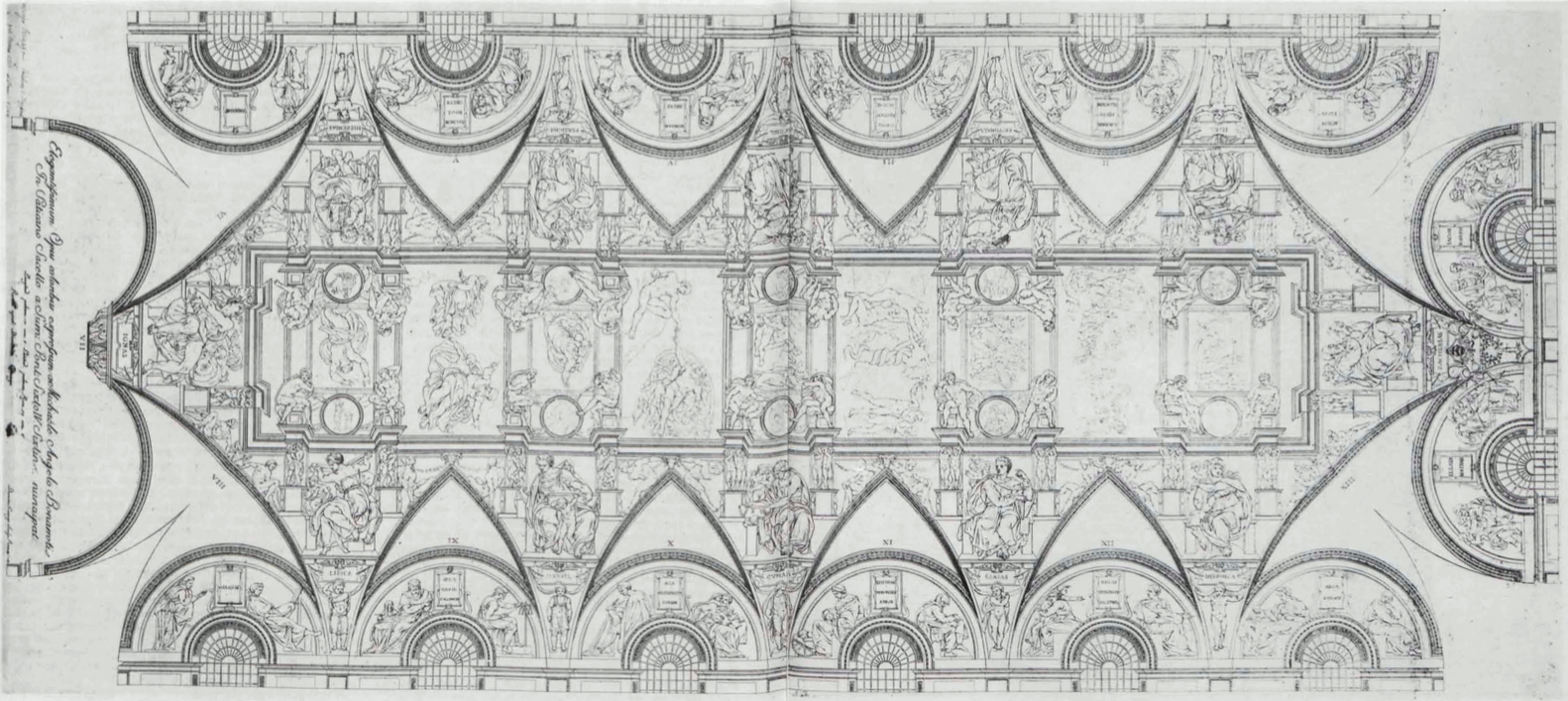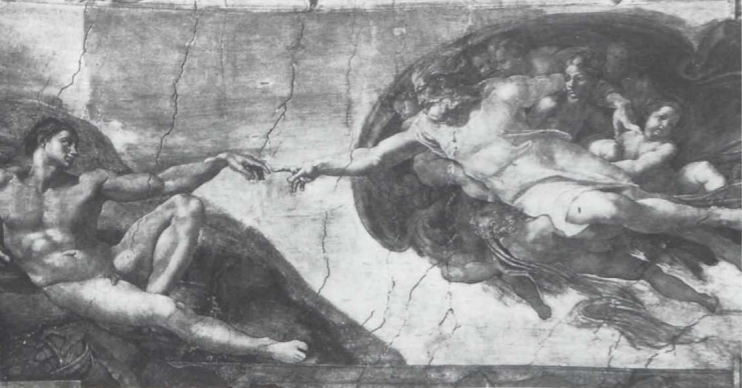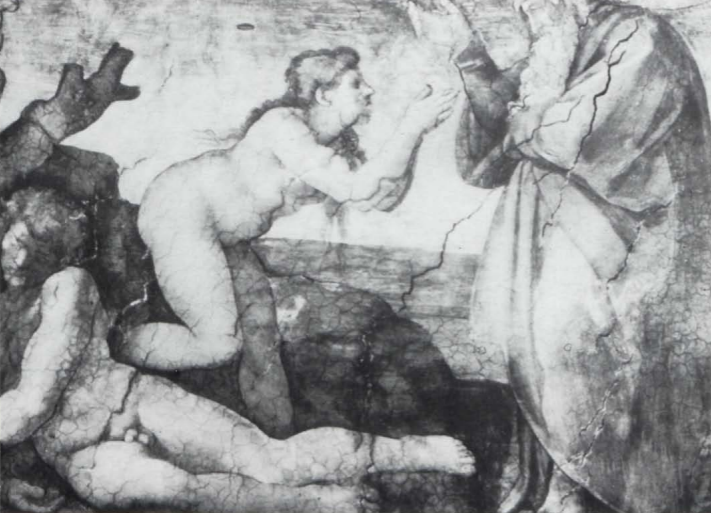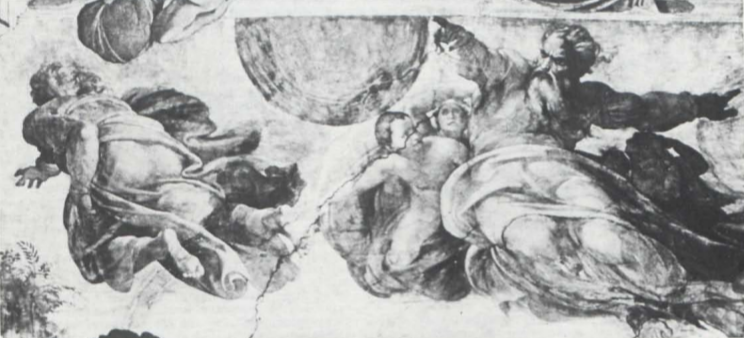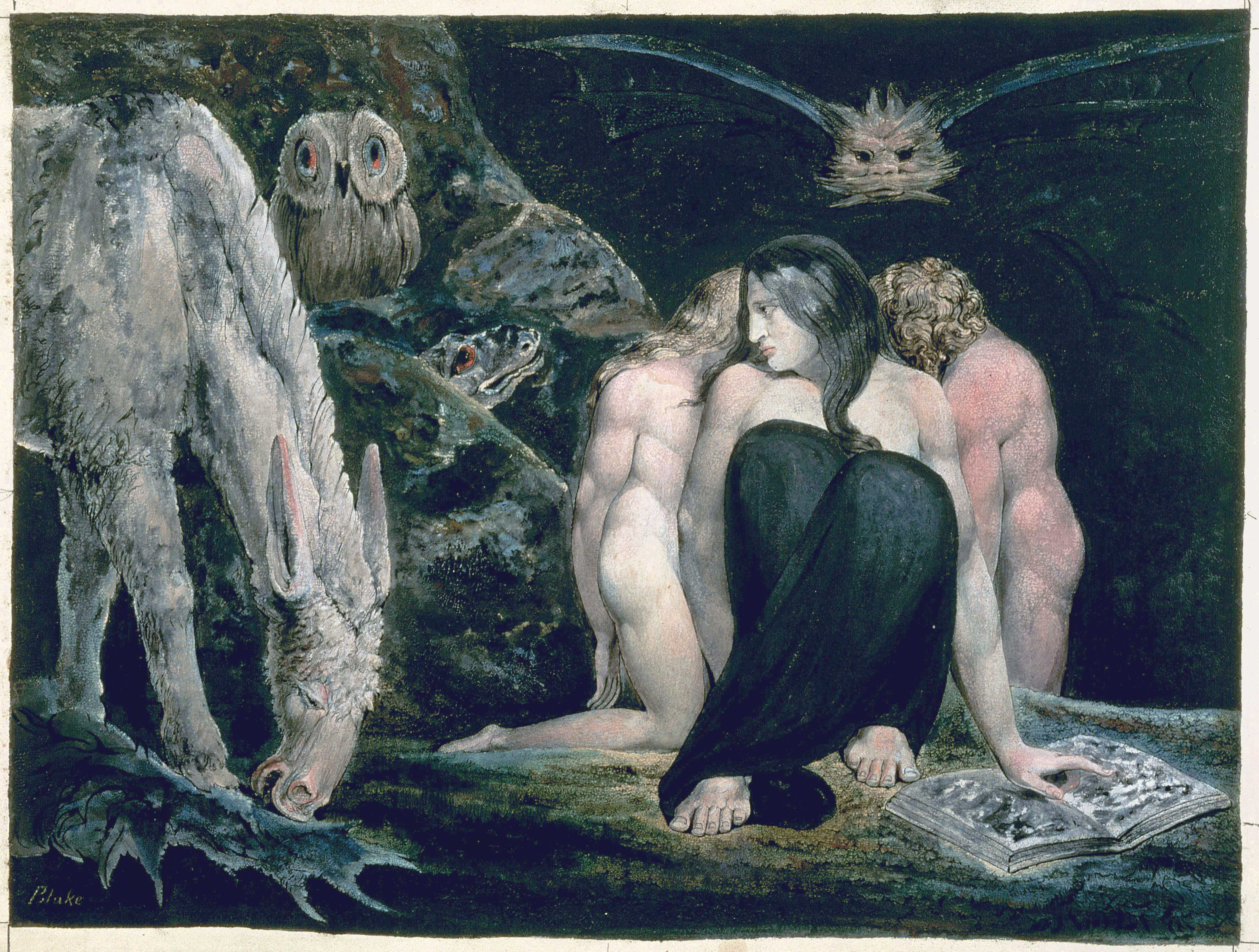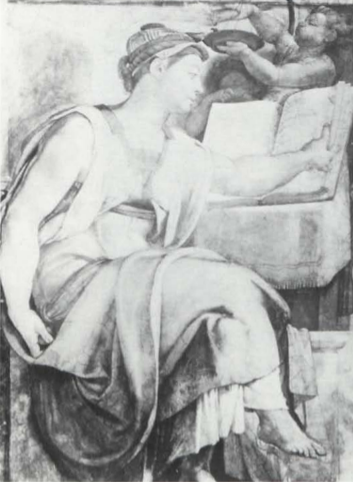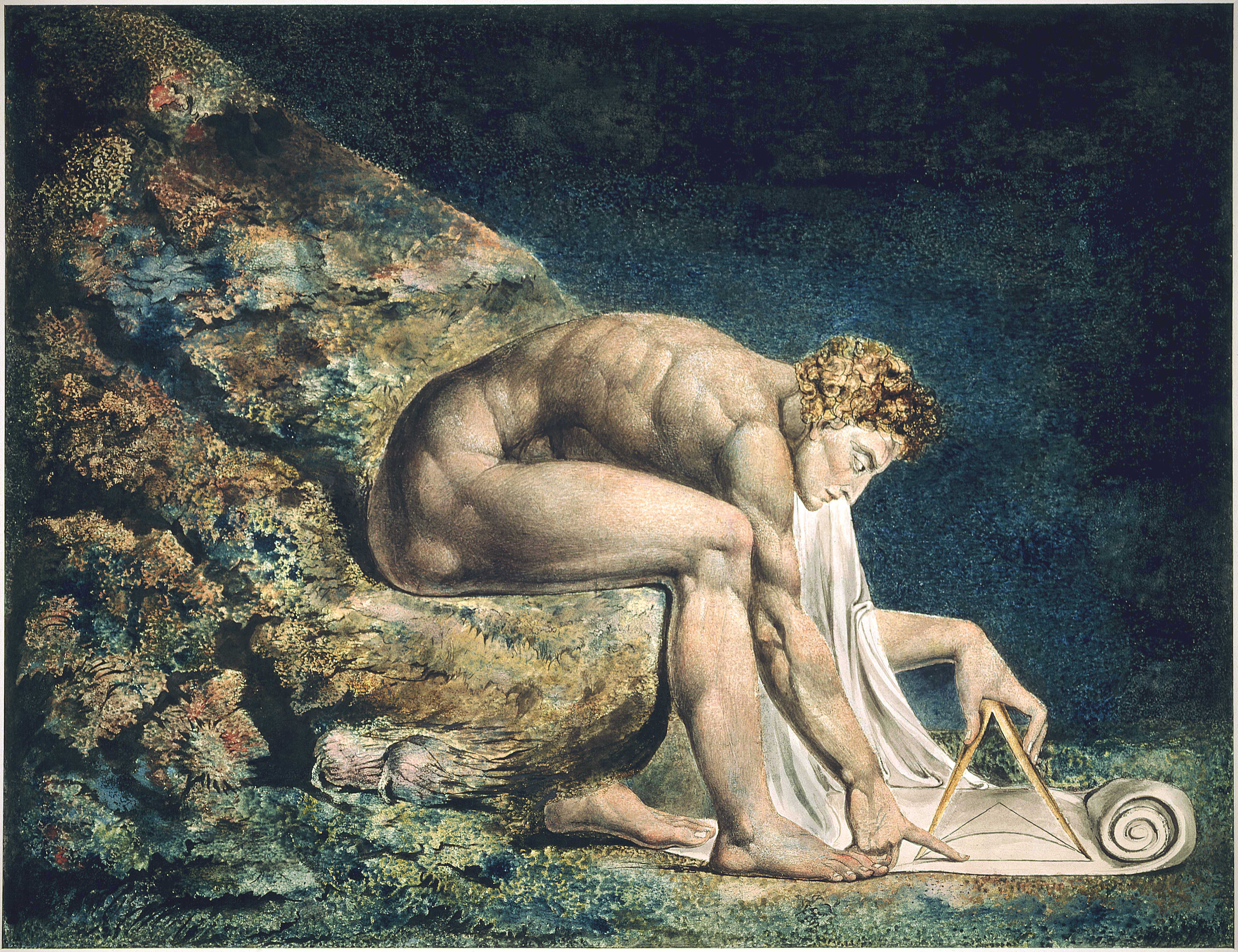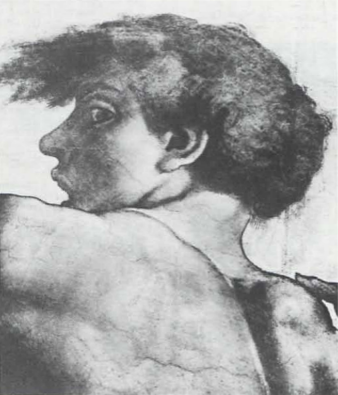article
begin page 66 | ↑ back to topMICHELANGELO’S SISTINE FRESCOES AND BLAKE’S 1795 COLOR-PRINTED DRAWINGS: A STUDY IN STRUCTURAL RELATIONSHIPS
William Blake’s large color-printed drawings of 1795 have often been recognized as among his greatest achievements in the visual arts. While some of the individual prints have received detailed attention, the interrelationships among all twelve designs have never been satisfactorily explained. The subjects of the prints range through both Biblical and secular literature: the Old and New Testaments, Shakespeare, Milton, and, perhaps, Blake’s own writings. The fact that the designs were all executed in the same technique in the same year, are of about the same size (approximately 45 by 58 cm.), and would seem to express similar emotions and basic concepts suggests that the prints may form a series. Yet the range of subject matter makes it extremely difficult to describe the format of such a group. A comparison, however, between the color-prints and Michelangelo’s frescoes on the Sistine Ceiling offers new insights into Blake’s work. As I will attempt to demonstrate here, Blake not only borrowed motifs and styles from Michelangelo for the creation of his great color-printed drawings, but also based their organization on the pictorial program of the Sistine Ceiling.1↤ 1 The most important published studies of the color-printed drawings are Martin Butlin, “The Evolution of Blake’s Large Color Prints of 1795” and Anne T. Kostelanetz, “Blake’s 1795 Color Prints: An Interpretation,” both in William Blake: Essays for S. Foster Damon, ed. Alvin H. Rosenfeld (Providence: Brown Univ. Press, 1969), pp. 109-16, 117-30; and Butlin, William Blake, catalogue of an exhibition at the Tate Gallery (London: Tate Gallery, 1978), pp. 59-65. See also Warren Jones’ unpublished doctoral dissertation Blake’s Large Color-printed Drawings of 1795 (Northwestern Univ., 1972). Briefer discussions may be found in David Bindman, Blake as an Artist (Oxford: Phaidon, 1977), pp. 98-100; Anthony Blunt, The Art of William Blake (N. Y.: Columbia Univ. Press, 1959), pp. 57-62; Butlin, William Blake (London: Tate Gallery, 1966), pp. [3-6]; and Morton D. Paley, William Blake (Oxford: Phaidon, 1978), pp. 37-8. None of these studies has considered the thesis I will present here.
Blake’s debt to Michelangelo is apparent throughout a great deal of his best work and has been mentioned by many Blake scholars.2↤ 2 See, for example, Blunt, The Art of William Blake, p. 35; Jean Hagstrum, William Blake Poet and Painter (Chicago: Univ. of Chicago Press, 1964), p. 40; and Anne Kostelanetz Mellor, Blake’s Human Form Divine (Berkeley: Univ. of California Press, 1974), pp. 126-31. The color-printed drawings are no exception. The heroic musculature of the figures, the brooding or terrified visages, the dramatic postures, and even the schematic simplicity of the backgrounds all bespeak Blake’s unbounded admiration for and borrowings from Michelangelo. Blake, of course, knew Michelangelo only through engraved reproductions, many of which were probably known to him from his earliest years. Blake’s very first signed engraving, Joseph of Arimathea among the Rocks of Albion, is based on a figure from Michelangelo’s fresco of the Crucifixion of St. Peter in the Cappella Paolina at the Vatican, and in the 1780s Blake meticulously copied seven of Michelangelo’s figures from the Sistine Chapel—following the engravings in a small book by Adam Ghisi.3↤ 3 I discuss the influence of these designs on Blake’s later works in “Blake’s Visions and Re-visions of Michelangelo,” Blake in His Time, ed. Robert N. Essick and Donald Pearce (Bloomington: Indiana Univ. Press, 1978), pp. 13-22. These careful studies from Michelangelo, as well as many other borrowings from his work, indicate that Blake knew the Sistine frescoes intimately. There were a number of engravings of the Ceiling available in Blake’s day, including Domenico Cunego’s outline print (105 by 48.3 cm.) of the ceiling, vaults, and lunettes, published in 1780 (illus. 1). The schematic linearity of this engraving places particular emphasis on the structure of Michelangelo’s designs, rather than on details of motif, expression, or color. Blake could have learned more about the Sistine Chapel from friends such as Flaxman, who returned from Rome in 1794, and Fuseli.
Blake wrote the word “Fresco” on five of the color prints,4↤ 4 These are Naomi entreating Ruth (Victoria and Albert Museum copy), Newton (Lutheran Church in America), God judging Adam (Metropolitan Museum, N. Y.), Christ Appearing to the Apostles (Rosenwald Collection, National Gallery of Art), and Hecate (National Gallery of Scotland). a word he also used to describe his so-called tempera paintings of a later date. He apparently believed that his own opaque glue or gum-based pigments and perhaps even his methods of preparing paper or canvas were the same as the fresco technique of painting on damp plaster used by the great Renaissance masters.5↤ 5 For descriptions of Blake’s color-printing technique, see Ruthven Todd, “The Techniques of William Blake’s Illuminated Printing,” The Visionary Hand: Essays for the Study of William Blake’s Art and Aesthetics, ed. Robert N. Essick, (Los Angeles: Hennessey & Ingalls, 1973), pp. 19-44; and Robert N. Essick, William Blake Printmaker (Princeton: Princeton Univ. Press, 1980), pp. 121-35. Blake hoped that his work in this medium would achieve the same greatness for his country and age that the works of begin page 67 | ↑ back to top Michelangelo and Rafael had achieved for the Italian Renaissance. In his Descriptive Catalogue of 1809, Blake wrote that he wished four of his drawings were “in Fresco, on an enlarged scale to ornament the altars of churches, and to make England like Italy, respected by respectable men of other countries on account of Art.”6↤ 6 The Poetry and Prose of William Blake, ed. David V. Erdman (Garden City, N. Y.: Doubleday, 4th printing, 1970), p. 539. All further quotations from Blake’s writing are from this edition, referred to hereafter as E followed by page number. That Blake believed, however wrongly, that his color-printed drawings were in the same medium as the Sistine Chapel frescoes forms a small but significant technical connection between Blake’s works and Michelangelo’s.
Before turning to specific comparisons between the color-prints and Michelangelo’s paintings, we must consider for a moment the relationships among the various sections of the Sistine frescoes themselves. The central span of the ceiling is dominated by nine panels recording the Biblical history of the world from the Separation of Light and Darkness to the Drunkenness of Noah. We enter the Chapel at the end of the story, under the Drunkenness of Noah, and proceed backward in time through the Deluge, the Sacrifice of Noah, The Fall and the Expulsion, the Creation of Eve, the Creation of Adam, the Separation of Heaven from the Water, the Creation of the Sun and Moon, and finally the Separation of Light and Darkness. If one conceives of the series as running in the other direction, from altar to entrance, then the central panels proceed in chronological sequence—yet with one exception. Noah’s sacrifice happened after the flood and therefore we should, when entering the room, come upon it as the second panel, not the third. Some modern scholars believe that Michelangelo desired the viewer to follow the reverse chronology and that he transposed the second and third panels because he wished not just to tell a Bible story, but to indicate a symbolic progression of human consciousness as it ascends from a beastly level to an awareness of God’s primal being.7↤ 7 The major discussion of this point of view can be found in Charles De Tolnay, The Sistine Ceiling (Princeton: Princeton Univ. Press, 1945), pp. 24-43. De Tolnay is generally considered to be one of the standard modern authorities on the Sistine paintings. Unfortunately, none of the discussions of the Sistine frescoes that Blake would have been familiar with goes beyond the barest description of the program of the ceiling. In this discussion I refer to several modern commentators, although of course Blake’s own interpretations would not have corresponded exactly to theirs. The parallels between modern interpretations of Michelangelo and the themes in Blake’s color-prints may be the result of a common source in the Sistine frescoes themselves. Michelangelo was conversant with the Christian Neo-Platonism of the Italian Renaissance,8↤ 8 See Erwin Panofsky, “The Neoplatonic Movement and Michelangelo,” Studies in Iconology: Humanistic Themes in the Art of the Renaissance (1939; N. Y.: Harper & Row, 1962), pp. 171-230; and Johannes Wilde, Michelangelo: Six Lectures (Oxford: Clarendon Press, 1978), pp. 58-63. and his organization of the ceiling was very likely influenced by a Neo-Platonic concern for the stages of spiritual enlightenment. We come upon the Deluge before the Sacrifice of Noah since the latter event indicates a turning to God and a growth of spiritual awareness. The parallels between Blake’s group of color-prints and the sequence of Michelangelo’s central panels hold true whether one reads the panels from entrance to altar (as I do here, following De Tolnay) or from altar to entrance (thus emphasizing a fall into sensual degradation rather than a progression toward enlightenment).
About the central sequence Michelangelo arranged several types of figures, related thematically but not sequentially to other parts of the entire composition. Again the concept of levels of spiritual awareness would seem to provide the organizational key. In the four corner spandrels are the deeds of Old Testament heroes which aided the earthly well-being of the Israelites. In the eight side spandrels are portraits of unredeemed humanity who, as St. Luke writes, “sit in darkness and in the shadow of death” (Luke 1:79). Between the spandrels are the largest figures on the ceiling—all of whom experienced a level of spiritual enlightenment that raised them above the earthly limitations of the spandrel figures. These majestic characters are of two types—Old Testament Prophets who foretold the destiny of their people and the coming of Christ, and the Sibyls, those female soothsayers of classical history whose words were seen as harbingers of the Christian era by Renaissance theologians. The spiritual struggles of these contemplative figures are given dramatic physical embodiment in the ignudi, youthful male nudes who serve as intermediaries between the seers and the central panels. Thus, Michelangelo has combined sequential narrative and a more open organization based upon levels of human consciousness—with the conceptual arrangement dominant over temporal order. By this flexible principle, Michelangelo has been able to bring together a vast array of events from both Biblical and non-Biblical history and to offer the viewer the opportunity to recapitulate on the psychological level man’s fall and progress toward redemption. We find a similar architectonic program in Blake’s color-prints of 1795.
The most famous and in many respects most important panel in Michelangelo’s central sequence is the Creation of Adam (illus. 2). We are not given the creation of Adam’s physical form, but rather the moment when God brings to man the divine spark of intellect. Adam seems to be rising physically from the primordial earth as an indication of incipient spiritual awareness. God’s heroic form framed by attendant spirits and a swirling cloak is an epitome of the eighteenth century’s sense of the pictorial sublime—a mixture of beauty and power that cannot fail to touch the viewer with awe. Yet God’s face expresses tenderness as well as majesty.
David Bindman has suggested that Elohim creating Adam (illus. 3) is “the most probable starting design” for Blake’s color-printed drawings and that its “ultimate prototype” is Michelangelo’s Creation of Adam.9↤ 9 Blake as an Artist, pp. 98-99. By “starting design,” I (and I suspect Bindman as well) do not mean that this was the first composition in the group that Blake began to work on. That distinction may belong to Pity. Besides the three full scale color-printed drawings of this design, it exists in two drawings, the earlier of which has a vertical major axis, and an incomplete color-printed drawing (British Museum) considerably smaller than all the other color-prints. In this investigation of the conceptual ties between Michelangelo’s entire series and Blake’s, the general similarities in subject and style are perhaps less significant than the contrasts that link these two designs. In Blake’s creation of Adam, we see not spiritual enlightenment, but the physical creation of Adam’s body—a body not rising from the earth but crucified upon it. God’s face mixes melancholy with terror and while this God may, like Michelangelo’s, touch us with awe, He gives us no hope. Rather than enlightening Adam, with His right hand He seems to be forcing Adam’s head closer to the earth. Like “the father [who] ready stands to form / The infant head” (E 281) in Tiriel, Blake’s Elohim is restricting, not expanding, human consciousness. With His left hand God reaches for more clay to add to Adam’s partially fleshed body. Adam’s lower limbs are bound by a worm, often associated with the merely physical in Blake’s writings10↤ 10 See, for example, Blake’s references to man as a “worm of sixty winters” in Europe (pl. 6, 1. 6), E 61; Tiriel (p. 8, 1. 11), E 281; Jerusalem (pl. 30, 1. 57), E 175; and “the Winding Worm” in Jerusalem (pl. 85, 1. 1), E 241. The worm in the color-print may have been suggested by Bildad’s statement in Job 25:6 that man “is a worm.” and, in this context, suggestive of the serpent who leads to man’s fall into mortality. In contrast to God’s attendants and cloak in Michelangelo’s creation of Adam, Blake gives his Creator gigantic wings, copied from a Greek portrayal of the Pagan god Skiron,11↤ 11 See C. H. Collins Baker, “The Sources of Blake’s Pictorial Expression” in The Visionary Hand, pp. 124-25 and n. 5 on p. 126. and, in the background, the mottled disc of the sun. Blake inscribed Elohim creating Adam on the only known impression of this design,12↤ 12 For basic information on inscriptions, sizes, and locations of copies of the color-printed drawings, see Butlin, William Blake: A Complete Catalogue of the Works in the Tate Gallery (London: Tate Gallery, 1971), pp. 34-41, and The Visionary Hand, pp. 37-38. thereby indicating that God is here the begin page 68-69 | ↑ back to top
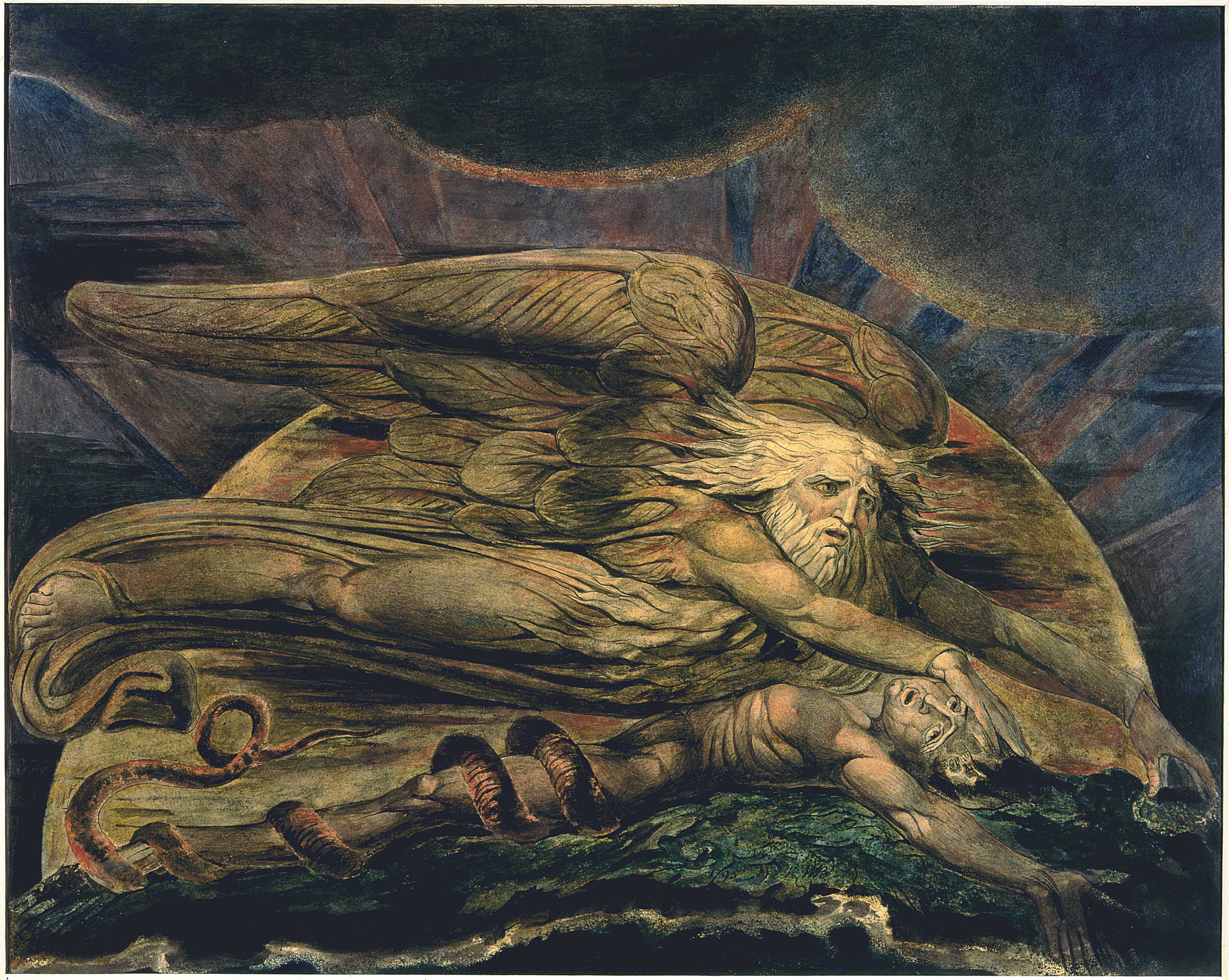
[View this object in the William Blake Archive]
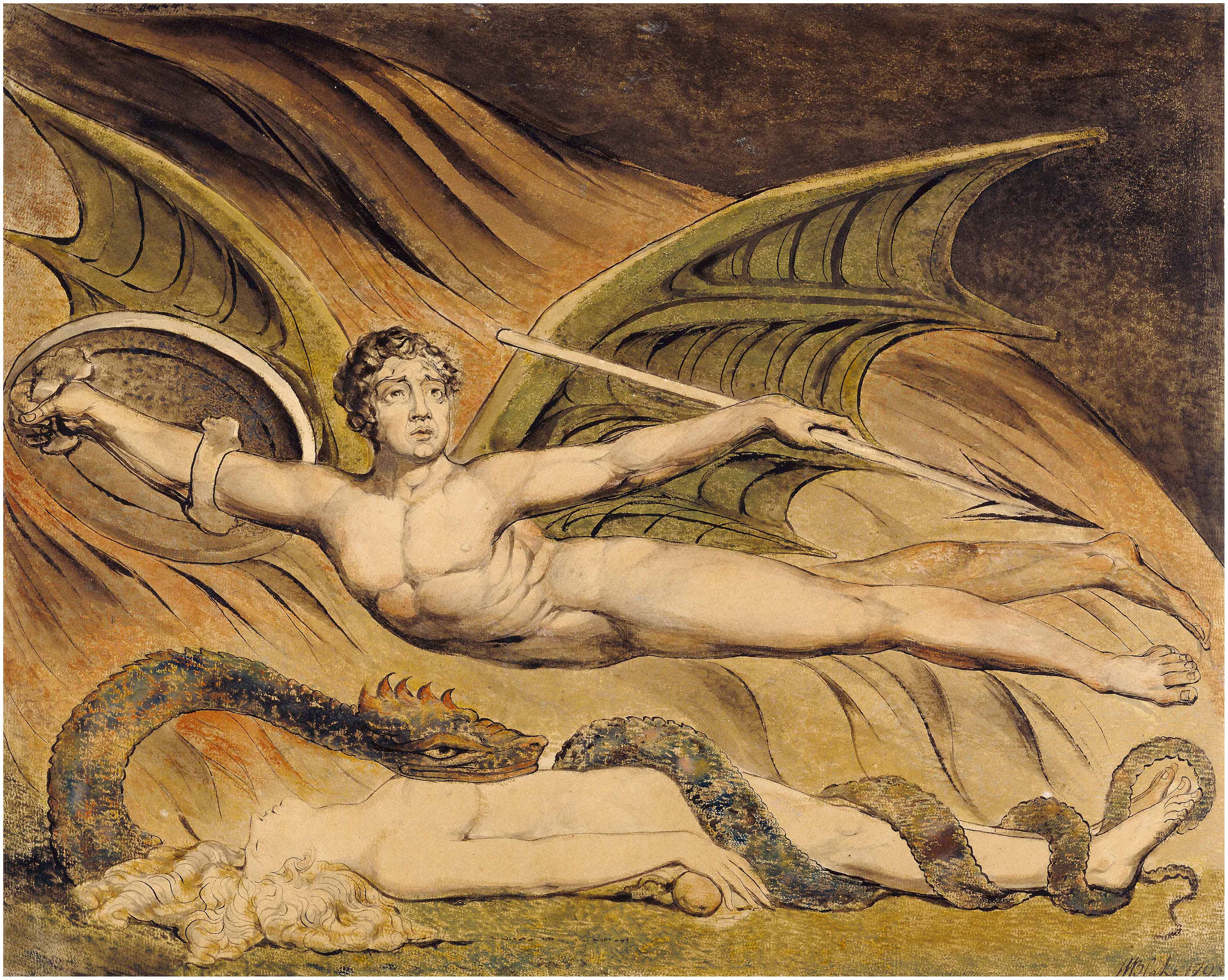
[View this object in the William Blake Archive]
Michelangelo’s Creation of Eve (illus. 4) embodies a lower level of intellectual consciousness than his creation of Adam. On the left is the inert form of Adam, clearly at this point a physical, not spiritual, being. Eve rises heavily from his side as if she were being levitated by God’s commanding right hand. And God, now enclosed by his mantle rather than soaring energetically before it, seems wrapped in solemn contemplation. Blake’s equivalent (illus. 5) shifts the scene to a later event—the exultation of Satan over the fallen Eve, the fatal apple under her right hand. Yet the close parallel in the arrangement of the figures between this scene and Blake’s creation of Adam suggests that Satan may also be the creator of Eve.14↤ 14 Similarly, Michelangelo suggests a parallel between his portrayal of the Creation of Adam (illus. 2) and the Fall and the Expulsion (illus. 6). In the latter design, the serpent’s gesture as she hands the apple of corruption to Eve mimics God’s gesture (in illus. 2) as He brings intelligence to Adam. In both color-prints we have scenes of simultaneous creation and fall, much as we do in the creation myth of The Book of Urizen. The worm wound about Adam is compositionally replaced in Satan exulting over Eve by a giant serpent, his head resting victoriously on Eve’s breast. A youthful and heroic, yet saddened, figure of Satan hovers like a triumphant warrior, spear and shield in hand, above his earth-bound victim and in front of hellish flames. Here again Blake has shifted Michelangelo’s prototype to an even darker view of human nature and Biblical history; yet he remains within the general compass of Michelangelo’s subject matter and organizational strategy.
Progressing backwards in states of consciousness but forward in the chronological narrative, we come to Michelangelo’s panel showing both the fall and the expulsion from the Garden of Eden (illus. 6). As we have seen, Blake’s first two color-prints embody images of the fall, and both contain a worm or serpent wrapped about the human form much as Michelangelo’s serpent wraps herself around the tree of the knowledge of Good and Evil. As far as we know, Blake never made a color-print of the expulsion; rather he shows us the central event which must necessarily come between the fall and the punishment—God judging Adam (illus. 7). A stern Elohim with his left hand on the tablet of the law comes to man in a blazing sun-chariot. His steeds with fiery manes would seem to be combinations of those two beasts Blake contrasts in The Marriage of Heaven and Hell—“the horses of instruction” and “the tygers of wrath” (E 36). Adam, bearing the burden of mortality, has grown as aged as his God. The gesture of God’s right arm and hand and the suggestion of a sword or shaft extending from his hand to Adam’s head recall the gesture and sword of the angel expelling Adam and Eve from Paradise in Michelangelo’s design.
Michelangelo’s three panels on the creation and fall are matched thematically and in their narrative relationships by three of Blake’s color-printed drawings. Given these significant parallels, reinforced in some cases by stylistic similarities and perhaps even a few borrowings of specific motifs, begin page 73 | ↑ back to top
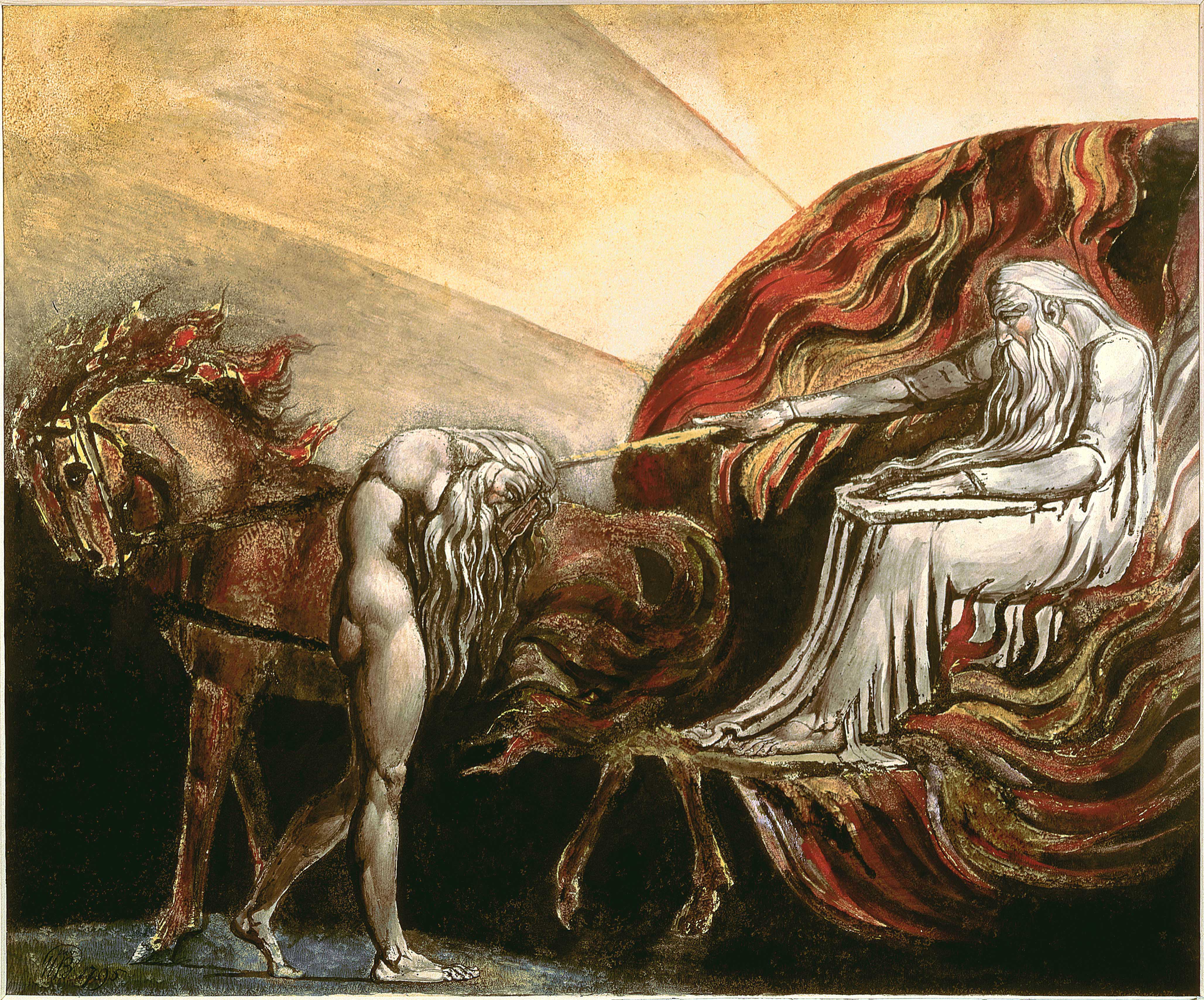
[View this object in the William Blake Archive]
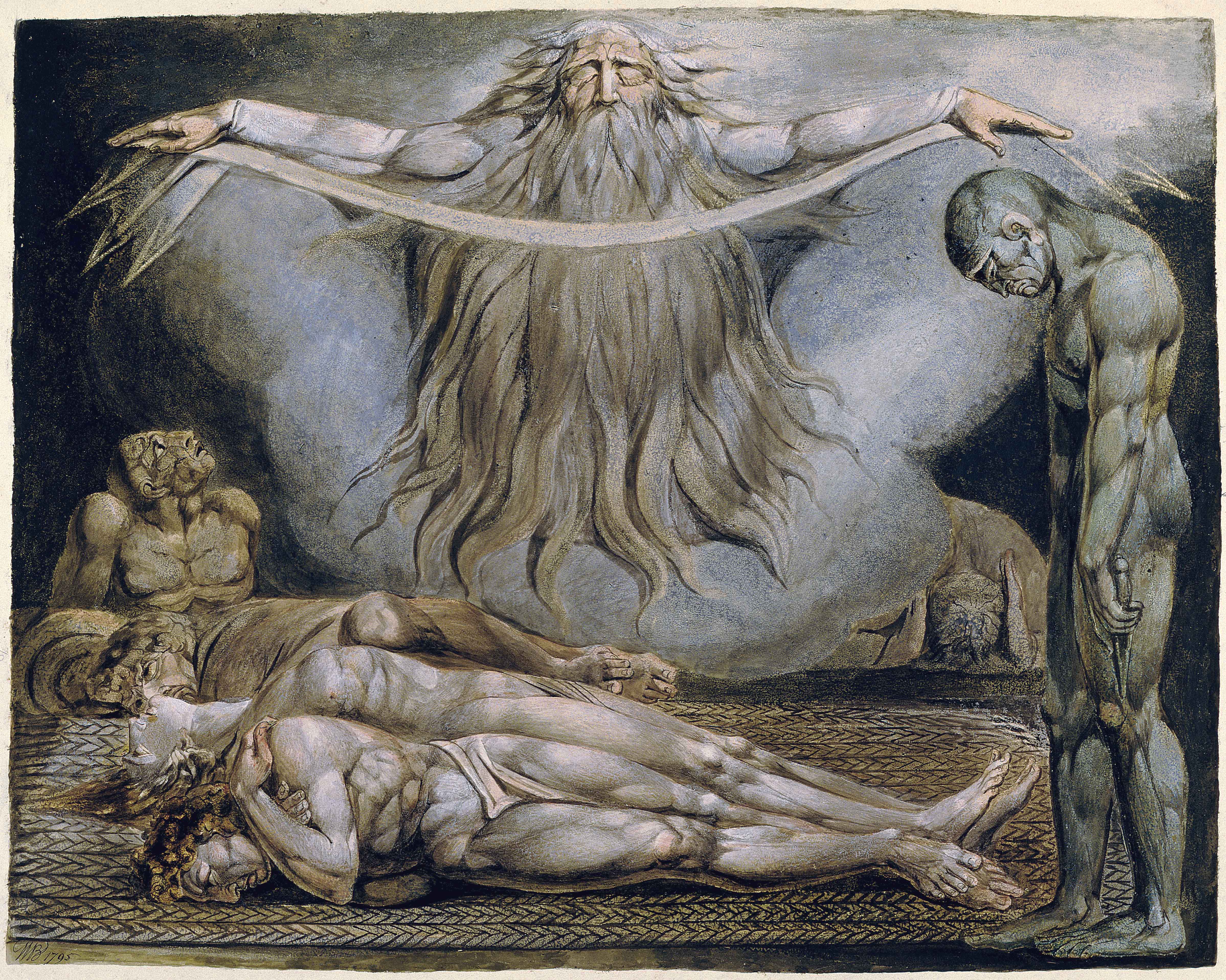
[View this object in the William Blake Archive]
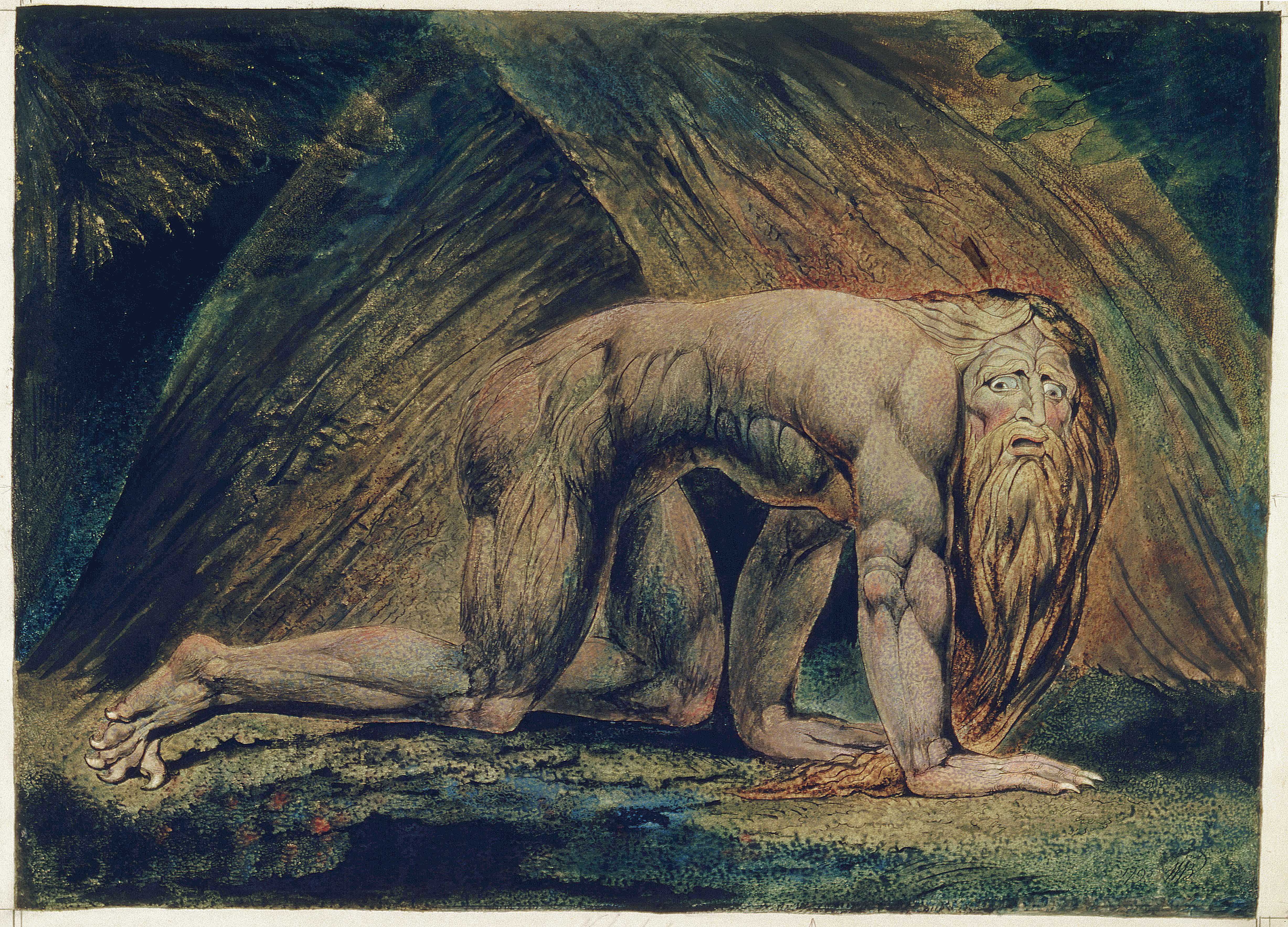
[View this object in the William Blake Archive]
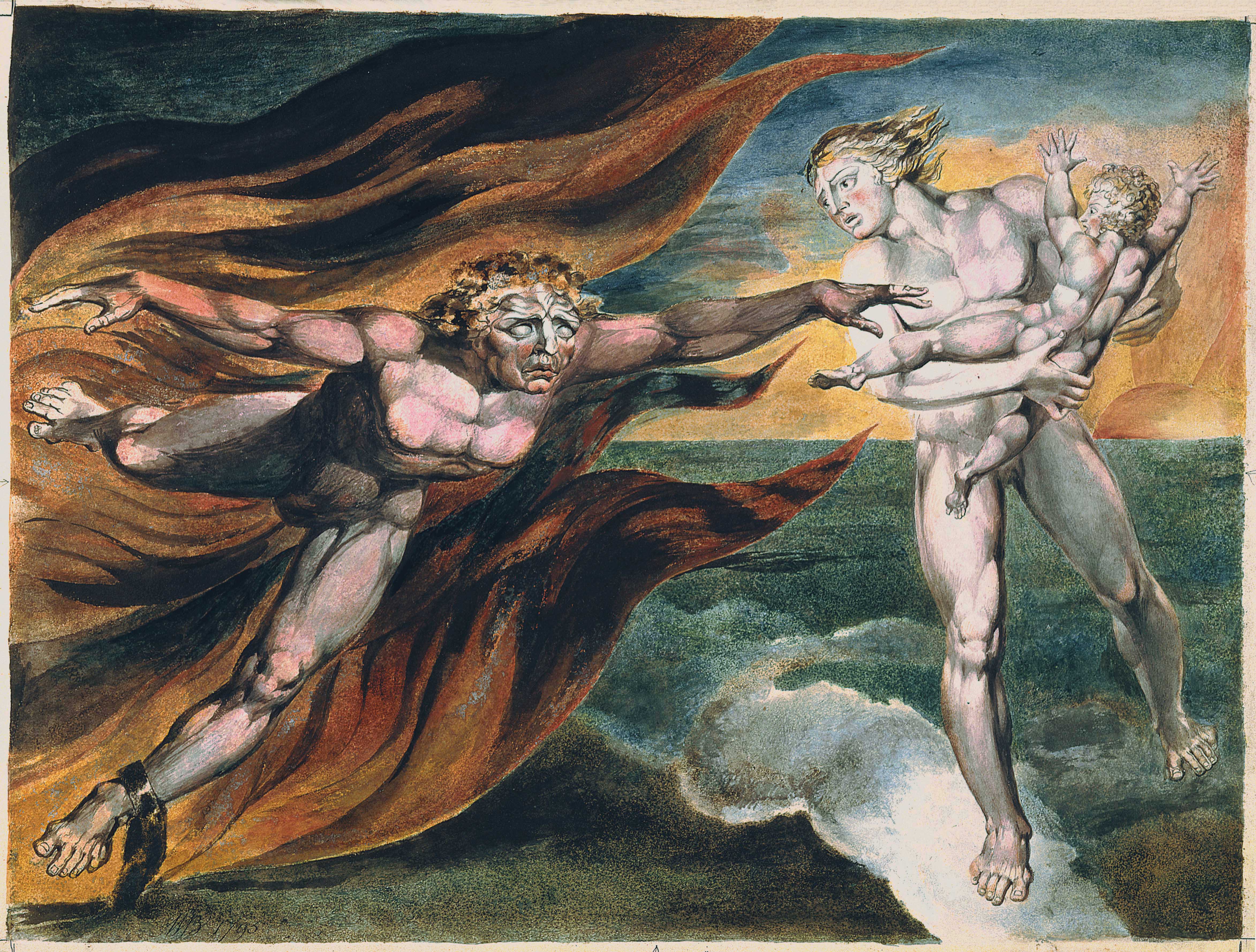
[View this object in the William Blake Archive]
Milton describes “a Lazar-house” ↤ 16 John Milton: Complete Poems and Major Prose, ed. Merritt Y. Hughes (N. Y.: Odyssey Press, 1957), p. 444.
wherein were laidBlake has personified these states of pain and despair in the six victims below the figure of Death, his features generally reminiscent of the Elohim we have seen earlier. His eyes closed, Death holds between his outstretched hands an object suggesting both a bow (from which his darts are about to be shot) and a scroll, a list of victims who will suffer the penalty of mortality announced in God judging Adam. Despair, standing on the right, does not so much tend to the sick as sink into thoughts of murder or suicide, emblemized by the dagger in his left hand.
Numbers of all diseas’d, all maladies
Of ghastly Spasm, or racking torture. . . .
Dire was the tossing, deep the groans, despair
Tended the sick busiest from Couch to Couch;
And over them triumphant Death his Dart
Shook, but delay’d to strike, though oft invok’t
With vows, as thir chief good, and final hope.
(Paradise Lost, XI, 479-81, 489-93)16
The lowest state of consciousness symbolized in the central Sistine panels is presented by the Drunkenness of Noah. Noah has sunk into a drunken stupor, into unconsciousness, and his nakedness is not an image of the human form divine but of the imprisonment of the soul in gross physicality. Blake’s Nebuchadnezzar (illus. 9) gives us a more horrific portrayal of an equally low, or even lower, state of bondage. The color-print illustrates a passage from the Book of Daniel:
The same hour was the thing fulfilled upon Nebuchadnezzar: and he was driven from men, and did eat grass as oxen, and his body was wet with the dew of heaven, till his hairs were grown like eagles’ feathers, and his nails like birds’ claws (4:33.)The Babylonian monarch has been reduced to a subhuman, animalistic condition—much as Michelangelo showed a hero at the moment of his greatest shame.
While following the conceptual scheme of the Sistine Ceiling, Blake has given us a darker vision of Biblical history and human consciousness than Michelangelo. The Sistine Adam receives divine intellect; Blake’s the imprisoning body. Michelangelo’s Eve rises into being; Blake’s sinks under Satan’s dominion. Michelangelo shows us the fall and expulsion; Blake gives us the direct act of judgement and the penalty of mortality brought to the aged Adam. The deluge kills but it also cleanses; the House of Death offers no amelioration of its punishment. Finally, Noah is still clearly a human form; Nebuchadnezzar has become half-beast. The two series of “frescoes” correspond to each other through contrariety, that structural relationship we so frequently find in Blake’s own works from the Songs of Innocence and of Experience to Jerusalem.
The three Sistine panels at the end of the room over the altar all portray God the creator. There has been some disagreement over exactly what is represented in each panel, but they would seem to be the following: the Separation of Heaven from the Water; next, the Creation of the Sun and Moon; and last, the Separation of Light and Darkness.17↤ 17 These titles are all from The Sistine Ceiling, pp. 37-40. Anthony Bertram calls the first panel in this group God Separating the Waters from the Earth in Michelangelo (London: Studio Vista, 1964), p. 41; Enzo Carli titles this same panel God Creates the Animals in All the Paintings of Michelangelo (N. Y.: Hawthorn Books, 1963), p. 28; and Herbert Von Einem calls the panel The Creation of the Creatures of the Sea in Michelangelo (London: Methuen & Co., 1973), p. 70. Von Einem points out that this scene “raised difficulties” even for Renaissance interpreters of the Sistine frescoes. In each case, Michelangelo presents primal acts of binary differentiation as the essential feature of divine creativity. Blake has embodied with equal mystery and force this basic process in The Good and Evil Angels (illus. 10). Blake first used a much smaller, cruder form of this design on plate 4 of The Marriage of Heaven and Hell (c. 1790) which has as one of its central themes the idea of contraries as the underlying structure for the moral distinction between good and evil. Blake writes that “Without Contraries is no progression. Attraction and Repulsion, Reason and Energy, Love and Hate, are necessary to Human existence. From these contraries spring what the religious call Good & Evil” (E 34). Thus Blake sees a causal connection between those creative acts which necessarily entail division and the contraries of good and evil personified in the color-print. Blake could have used this same line of reasoning to generate his design in response to the three panels where Michelangelo shows the creation of contrary states: heaven and earth, land and water, sun and moon, darkness and light. Rather than showing the creator, Blake pictures the created, with man as a child struggling between opposing forces, much as Michelangelo’s ignudi are caught between base materiality and a higher state of consciousness.18↤ 18 Bertram describes the ignudi as “thrusting against their imprisonment,” trying “to break out of the bondage of the world” (Michelangelo, p. 70). Compare, particularly, the face of the child in The Good and Evil Angels with the head of the nude youth above and to the right of the Persian Sibyl. The leftward turn of the head, open mouth, bridge of the nose (distinctly different from Blake’s usual classically straight nose), flashing eye, and general expression of terror are almost identical (see illus. 19). Compare also the face of the angel on the right in Blake’s color print with the nude youth above and to the left of the Prophet Daniel. Both of these ignudi frame the Separation of Heaven from the Water, one of the three panels to which The Good and Evil Angels is conceptually related. The design includes the four classical elements—fire on the left with what may be its personified form shackled by the left ankle to the earth below, and, on the right, water with the air above. Both Blake and Michelangelo are embodying in their designs the same elemental process, and both are more concerned with the dramatic presentation of energy than with straightforward narrative. The visual parallels between the chained figure in the color-print and the portrayal of God on the right in Michelangelo’s Creation of the Sun and Moon (illus. 11) hint at the more important conceptual similarities. De Tolnay’s description of the Sistine figure can be applied with equal validity to Blake’s chained angel:
His being is of a fiery nature: His face is illuminated by a red glow. . . . His hair floats like fiery tongues blazing from His strongly built forehead. In the downward curve of His mouth and the wrinkles of His forehead is marked His superhuman will. . . . His body describes a curve which swings upward to terminate in the extended arms which burst forth diagonally from His body. (p. 38)The figure on the left in Michelangelo’s panel is another view of the same creator. Similarly, Blake’s two angels may be the two halves or contrary states of the same principle. Although the drama in Blake’s color-print is presented through very specific motifs, the theme is as universal as the acts of creation represented by Michelangelo: Blake is calling us to a perception not of any specific binary opposition, but of the nature of binary opposition as a psychological and philosophical category. begin page 77 | ↑ back to top
Blake’s six color-printed drawings I have considered so far correspond in a variety of important ways to Michelangelo’s central panels. Three of the remaining prints follow conceptually Michelangelo’s corner spandrels. The iconographic significance of the corner compartments and their relationship to the entire composition are complex. One can emphasize the heroic context of these scenes and the way in which the events portrayed contributed to the triumph of the Israelites. Typologically, these scenes may even refer to Christ. On the other hand, these incidents may be seen as tragic. For example, one design has been alternately titled The Triumph of Esther and The Punishment of Haman.19↤ 19 For the first title see Carli, All the Paintings of Michelangelo, p. 31; for the second, De Tolnay, The Sistine Ceiling, p. 96. The three other scenes, David and Goliath, Judith and Holophernes, and The Brazen Serpent, also emphasize violent deaths rather than the salvation they foretell. Three of Blake’s color-prints are similarly poised between tragedy and divine comedy, with the visual emphasis on the former. Lamech and His Two Wives (illus. 12) returns us to a story in Genesis (4:23-24)—the murder of a young man20↤ 20 The Hyacinthine curls of the fallen figure are characteristic of Blake’s youthful males. See, for example, Orc in America, Albion rose, and Newton (illus. 17). The youth may be Tubalcain—see William Blake in the Art of His Time, exhibition catalogue, Univ. of California, Santa Barbara, 1976, p. 84. by Cain’s great-great-great grandson. Lamech pulls at his hair in despair over the penalty which will fall on him seventy and sevenfold while his wives cling to each other for comfort. The Biblical story offers no hope, but by suggesting a cruciform posture in the fallen youth, Blake may be hinting at typological possibilities much as Michelangelo does in his proto-crucifixion scenes, The Punishment of Haman and The Brazen Serpent. The bold and oddly abstract corner of a tent trusting into the design at the left margin may have been suggested to Blake by the similarly schematic background tent in Michelangelo’s David and Goliath. A further parallel comes to us by way of contrast: in David and Goliath, youth heroically slays age; in Lamech, age tragically murders youth.
The finest copy of Naomi entreating Ruth and Orpah to return to the Land of Moab (illus. 13), like the best impression of Lamech and His Two Wives, has its corners cut off on a diagonal. This fact, as well as compositional similarities, links the two designs.21↤ 21 Suggested in Butlin, William Blake, exhibition catalogue (1978), p. 62. Further, both deal with family turmoil, division, anguish, and pity. Naomi entreating Ruth, much more than Lamech, is ambiguously poised between tragedy and restoration. Naomi, on the left, is pictured as an old woman with a somewhat sinister visage and a veil draped over her head, linking her to figures in the Night Thoughts designs who may be prototypes for Vala.22↤ 22 See Night Thoughts watercolors (Night VII, p. 22), Night Thoughts engravings (Night II, p. 35), and my discussion of these figures and their basis in Blake’s drawing of Michelangelo’s Solomon lunette in Blake in His Time, pp. 17-18. Yet she is given a halo in the Victoria and Albert Museum copy and assumes a Christlike posture (cf. illus. 18) with the palms of her hands turned outward. Ruth cleaves to her even though this will carry her away from family and homeland (Ruth 1:11-17), much as the apostles sacrificed their familial bonds to follow Christ. And the two women will travel to Bethlehem in typological anticipation of the journey of Joseph and Mary.
The pathetic qualities latent in Naomi entreating Ruth and Lamech are directly personified in Pity (illus. 14). Blake never inscribed a title on the known copies of this color-print, but Frederick Tatham indicated what is very likely the subject and source for the design: the images of “pity, like a naked new-born babe, / Striding the blast” and of “Heaven’s cherubin horsed / Upon the sightless couriers of the air” are from Shakespeare’s Macbeth.23↤ 23 Tatham’s title inscription appears on one of the two preliminary pencil drawings of the design in the British Museum. It is interesting to note that in the late 1770s Henry Fuseli did a series of sketches (now in the British Museum) illustrating Shakespeare in a format based loosely on the Sistine Ceiling. These drawings, perhaps only imaginative experiments rather than preliminaries for actual frescoes, include a group of lunette and spandrel designs for Macbeth. See Gert Schiff, Johann Heinrich Füssli (Zurich: Verlag Berichthaus, 1973), I, 108-09, II, 113; Henry Fuseli, exhibition catalogue (London: Tate Gallery, 1975), pp. 72-73. Like the last two color-prints considered here and like Michelangelo’s corner spandrels, the iconography of the design is complex and somewhat ambiguous—as demonstrated by the differences in the interpretive comments Pity has elicited.24↤ 24 Butlin associates this design with pity “as a negative force” in Urizen in William Blake: a Complete Catalogue of the Works in the Tate Gallery, p. 38; Paley points out that “Pity introduces another gleam of grace into the nightmare world of the colour prints” in William Blake, p. 38. The latter view would seem to gain support from the similarity between the child in Pity and the infant Jesus, soaring between the swooning Mary and Saint Elizabeth’s outstretched arms, in both Blake’s tempera The Nativity (c. 1799) and The Descent of Peace in the Huntington Library set of watercolor illustrations (c. 1808) to Milton’s “On the Morning of Christ’s Nativity.” In the Book of Urizen of 1794, pity is associated with the fallen world and the divisive creation of the first female. The prone figure in the design also recalls Eve in Satan exulting over Eve. On the other hand, pity is not always a negative emotion in Blake’s writings, and, as personified as a child in the color-print, would seem to represent life, energy, and freedom within an otherwise dead or darkened world. The ambiguities of this design are similar to those in Blake’s aphorism in “The Human Abstract” (Songs of Experience, 1794) that “Pity would be no more / If we did not make somebody poor.” However valuable pity is in a fallen world, it is still the product of an evil deed. In Macbeth, the pity will result from a murder, and perhaps Blake seized upon this passage because it presents the paradoxical birth of a virtue out of a vice. Similarly, the Sistine corner spandrels prophesy political and even spiritual liberation resulting from bloody and terrible events.
Some of the most illuminating parallels between the organization of the Sistine frescoes and Blake’s color-prints are between Michelangelo’s Sibyls and Prophets and Blake’s two designs, Hecate and Newton, designs which would seem to present the most difficulties in any attempt at fitting them into a structured group with the other color-printed drawings. Around his central sequence of nine panels Michelangelo arranged gigantic figures of five Sibyls alternating[e] with seven Prophets. The female soothsayers have their dark parallel in Blake’s Hecate (illus. 15), a figure traditionally associated with necromancy and prophecy. Although the Sibyls did not, of course, know the Christian possibilities in their predictions, their sayings were transformed by Christian commentators into prophecies of Christ’s coming. Hecate is their contrastive analogue, much as black magic relates to white; she foretells not enlightenment, but mystery and the same sort of imprisonment of the human spirit we have seen in Elohim creating Adam and Nebuchadnezzar. Ever since Rossetti’s catalogue of Blake’s art appeared in 1863,25↤ 25 W. M. Rossetti’s “Annotated List of Blake’s Paintings, Drawings, and Engravings” in Alexander Gilchrist, Life of William Blake (London and Cambridge: Macmillan, 1863), II, 238, no. 228. this design has usually been associated with Shakespeare’s references to Hecate in Macbeth and A Midsummer Night’s Dream, although Paley has pointed to Virgil’s Aeneid, translated by Dryden, as a possible source.26↤ 26 William Blake, p. 38. The most significant references to Hecate in Dryden’s translation of the Aeneid are in the Sixth Book in conjunction with the activities of the Cumaean Sibyl, one of the five portrayed by Michelangelo. There are also several references to Triple Hecate in the Seventh Book of Ovid’s Metamorphoses. begin page 78 | ↑ back to top
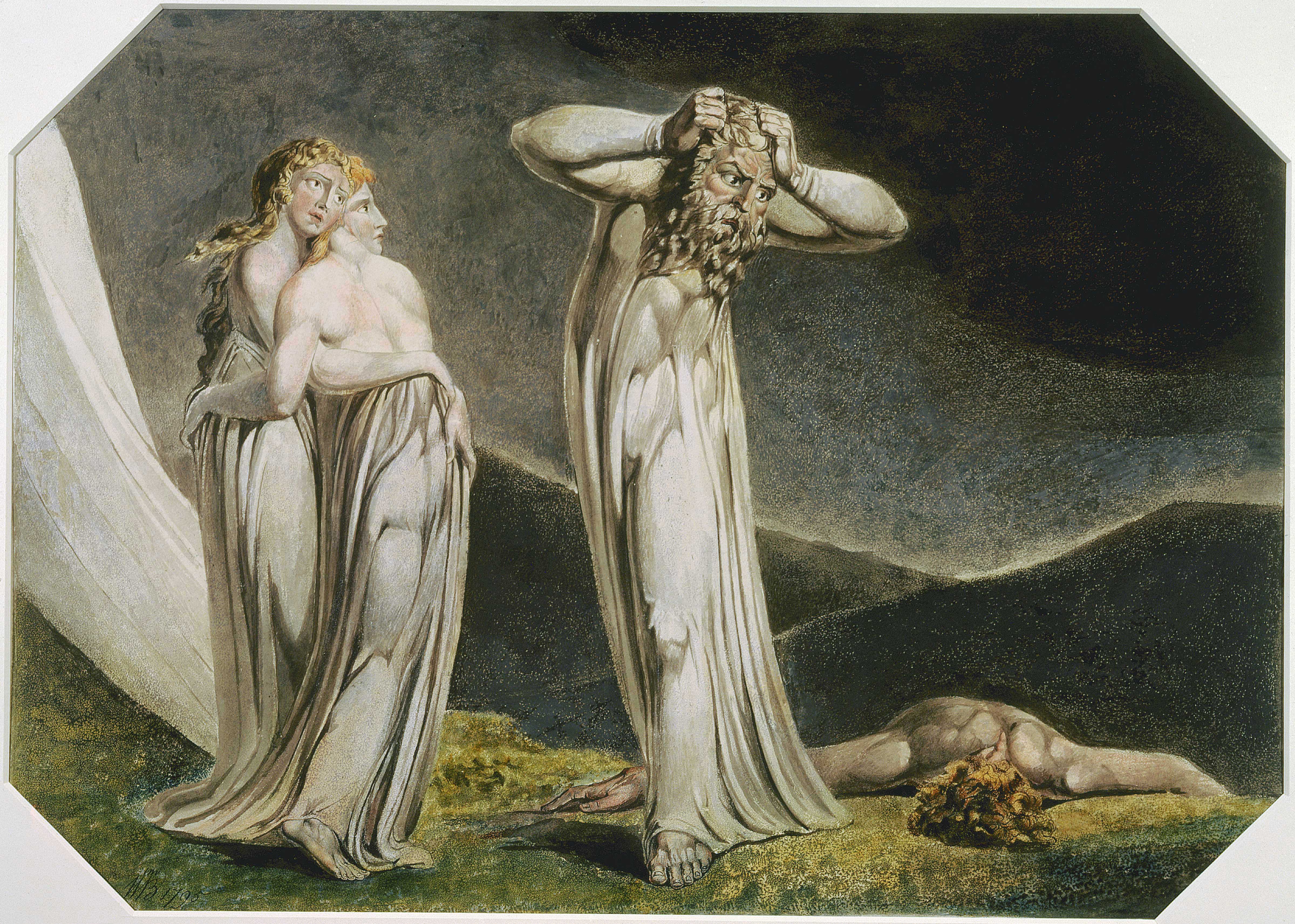
[View this object in the William Blake Archive]
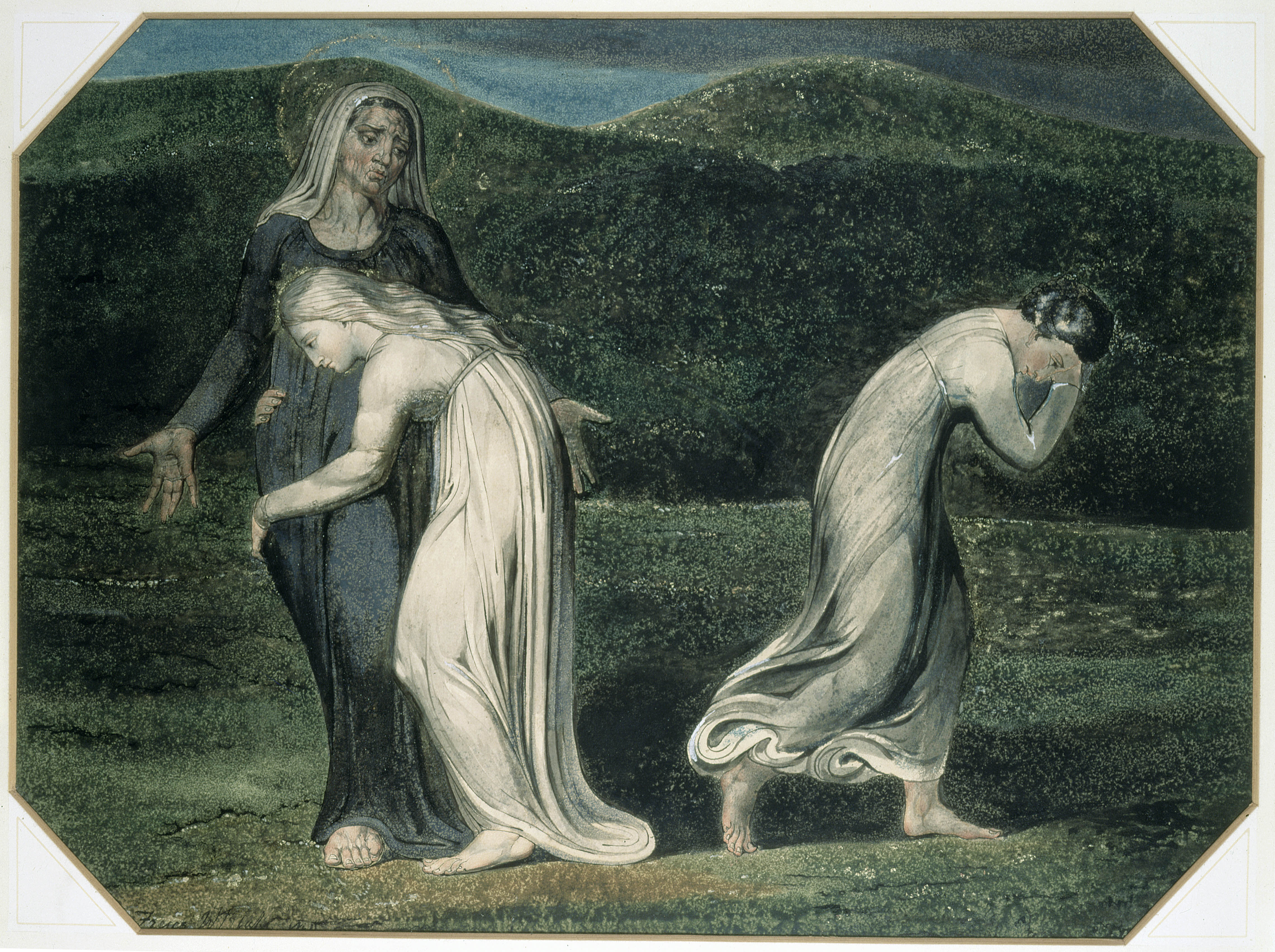
[View this object in the William Blake Archive]
The Gods all Serve her [Envy] at her will so great her Power is [.] like. fabled hecate She doth bind them to her law. Far in a Direful Cave She lives unseen Closd from the Eye of Day. to the hard Rock transfixt by fate and here She works her witcheries. (E 438)These possible literary sources fit within the compass of Michelangelo’s pictorial presentation of the Sibyls. Four of the Sibyls have large open books and one holds a scroll (but has a book behind her). The prophetic character of these writings finds its antithesis in Hecate’s book of mystery or law, similar to Urizen’s book (Book of Urizen, plates 1 and 5) in the illegible swirls of color-printing on its leaves. Behind each of Michelangelo’s Sibyls are two Genii, personifications of their inspired imaginations. And in Blake’s color-print we have two strange figures which are so intimately associated with the main human form in the composition that they would seem to be, like the Genii, projections of the internal nature of the Triple Hecate. The kneeling figure on the left appears to be female, and that on the right, male—the two universal principles of human character whose relationships play such a major role in Blake’s writing. The animals further associate the main figure with the divisive, fallen world, for they are creatures of darkness (owl, lizard, monstrous bat) or, like the donkey, are bound by necessity to the vegetative world. In her crossed-leg posture, with a mantle over her knees but the upper part of her body and her feet exposed, Hecate’s presentation corresponds visually to the twisted postures of the Sibyls, their uncovered feet, and the bare upper torso and arms of the Libyan Sibyl. Further, the Erythraean Sibyl’s right hand (illus. 16), like Hecate’s, falls within a fold of her garment, and her left hand touches the pages of an open book. Yet these admittedly minor visual similarities are less significant than the conceptual ones. The Sibyls prophesy liberation from bondage to the material world and point toward that higher vision the viewer must entertain to experience the expansion of consciousness presented by Michelangelo’s central panels. In antithetical parallel, Hecate is the female embodiment and interpreter of the fallen state of consciousness and of bondage to the material world dominating Blake’s color-prints, as well as his writings, of the mid 1790s.
The role played by the Prophets in the Sistine frescoes is fulfilled in Blake’s series by Newton (illus. 17). As De Tolnay points out, Michelangelo accentuated the “indecision, passivity, and ambiguity” of the Sibyls and placed them “nearer to nature and to the earth” than the Prophets, who exemplify “intellectual concentration” (p. 57). Hecate and Newton have a similar relationship: Hecate presents the dark mysteries of the fallen world; Newton the attempt by fallen reason to understand that world through mathematical and geometric abstraction. The great British scientist of the seventeenth century was for Blake the prophet of the rational philosophies and natural religions ruling the intellectual life of the eighteenth century. Newton’s prophetical character is demonstrated by the role he plays in Europe (1794):
The red limb’d Angel siez’d, in horror and torment;Newtonian philosophy—not so much Newton’s scientific discoveries as the application of his theories to moral and religious thought—is the herald of the French Revolution, itself a harbinger of “the last doom.” Michelangelo’s Prophets, with their books and scrolls, foretell release from mortality through the coming of Christ. Blake’s Newton, working with rapt attention on his scroll, embodies the rationalist and abstract thought which will lead to an inevitable revolt against such thought and the material world to which it is bound.
The Trump of the last doom; but he could not blow the iron tube!
A mighty Spirit leap’d from the land of Albion,
Nam’d Newton; he siez’d the Trump, & blow’d the enormous blast!
(E 63)
This color-print is in many ways the most remarkable in the series because of both its unusual begin page 81 | ↑ back to top subject and its great beauty. It is very likely an underwater scene with Newton immersed in the waters of materialism, “the sea of Time & Space.”27↤ 27 This image is first used in The Four Zoas, Night the Fourth, p. 56, line 13 (E 331). See Essick, “Blake’s Newton,” Blake Studies, 3 (1971), 149-62. The rock on which he sits is covered with what may be lichenous growths and just beneath him are two polyps that look like sea anemones. Newton’s rock assumes the same pictorial function in this color-print as the rock jutting in from the left in Hecate, a compositional similarity which further links these two designs much as Michelangelo’s Prophets and Sibyls are associated through visual parallels. This rock may be based on the similar motif in Michelangelo’s Creation of Adam and Creation of Eve. Newton attempts to understand his world through the simple geometric diagram he is measuring with compasses. What he fails to perceive is his own magnificent “human form divine” (“The Divine Image,” E 12), a form which links man to God, not to the world of undersea vegetation. Newton’s failure of perception may be the reason that Blake bases his visual portrayal of the scientist (as distinct from the figure’s programmatic role) not on one of Michelangelo’s Prophets, but on the Abia lunette (also part of the Sistine ceiling frescoes), for Abia is a representative of fallen and unenlightened humanity.28↤ 28 See Blake’s wash drawing of the Abia lunette (British Museum), reproduced in Blake in His Time, pl. 13. Daniel, one of the Prophets, is also included in this group of drawings (Blake in His Time, pl. 25). Much as Hecate is the Blakean antitype to Michelangelo’s Sibyls, Newton is the fallen form of Michelangelo’s Prophets.29↤ 29 Butlin (Blake, 1978, p. 64) associates Hecate with Pity because they may both have sources in Shakespeare and they emphasize vegetative nature. Clearly, however, the visual character of Hecate links it to Newton: the landscape in both designs is divided by a diagonal, running from upper left to lower right, created by the edge of a rocky ledge. Both rocks are inhabited by unusual creatures, and Newton’s scroll is paralleled by Hecate’s book. There are, of course, many thematic and visual interconnections among all the color-printed drawings, just as there are among Michelangelo’s frescoes.
Blake’s idealized portrayal of Newton’s body contains a potential for salvation through the realization of man’s divinity. The central realization of the human form divine in Blake’s later works is Christ, who is both man and God. He is not represented in the Sistine Ceiling, but many of the
individual motifs and the conception of the whole point toward His coming. As Bertram writes, “Everything in the ceiling . . . leads up to Christ, but He appears nowhere. The most satisfactory explanation of this astonishing omission is that Michelangelo did not consider that Christ’s real presence in the Sacrament on the altar needed any painted substitute.”30↤ 30 Michelangelo, p. 37. The Last Judgement on the west wall behind the altar was a later addition to the chapel and not part of Michelangelo’s original format for the ceiling frescoes. Blake, having no chapel and no altar with its sacraments, does give us a vision of Christ (illus. 18). It is the culmination of this linear group and an answer to the problems of material and spiritual bondage presented in the other eleven color-prints. Christ Appearing to the Apostles after the Resurrection is consistent with the dark vision of the other designs in that Christ is not shown in glory, but rather at the moment when He reveals to His followers His stigmata, those emblems of His own mortal sufferings and His own crucifixion in the fallen world of man. He is indeed the new Adam, but for Blake one who has undergone the same cruciform bondage to the world and the flesh shown in the first color-print considered here. Again, salvation is not presented in its full glory but as a potential within the darkness of this world. Blake hovers between hope and despair, between divine comedy and earthly tragedy. It is only in his later poetry and paintings that he transforms this image of suffering into the triumphant ideal.In the illuminated books and his intaglio print series The Gates of Paradise, we can see Blake absorbing and then transforming the conventional eighteenth century formats of illustrated books and of numbered sequences of emblematic pictures. He needed the traditional systems, but often assumed an adversary relationship with them, struggling with the old forms in order to open them to new possibilities. The standard eighteenth century format for a series of narrative prints was the Hogarthian Progress. A less adventuresome artist than Blake would have arranged a series of prints in general accordance with Hogarth’s schema. Blake required a more flexible model which could encompass more than direct causal and temporal relationships, just as in his poetic narratives he had, by 1794, developed the polysemous vision and non-linear narrative of The Book of Urizen. Michelangelo’s frescoes, linking Biblical and non-Biblical subjects, provided just such an expansive and comprehensive form for Blake’s own group of “frescoes.”
If we treat Blake’s color-printed drawings as a collection to be experienced in sequence and as though they were true frescoes on the walls of a room, like the Sistine Chapel or Job’s chamber in Blake’s Plate 20 of his engraved illustrations, then the color-prints can unfold before us like Michelangelo’s paintings. Blake’s group begins with three designs (Elohim creating Adam, Satan exulting over Eve, God judging Adam) that parallel in subject three of Michelangelo’s central panels (Creation of Adam, Creation of Eve, The Fall and the Expulsion). Next we come upon two designs (House of Death and Nebuchadnezzar) showing the despair and degradation of man also portrayed in Michelangelo’s Deluge and Noah. The elemental acts of creation and division in Michelangelo’s three panels nearest the altar are summarized in The Good begin page 82 | ↑ back to top

[View this object in the William Blake Archive]
It is difficult to prove, given the information we have, that Blake consciously modeled his color-prints on the Sistine Ceiling, but the organizational parallels between these two groups are strong enough to indicate, at the very least, an indirect influence. It is certainly safe to assume that Blake knew the Sistine designs so well that their structure had become part of his own artistic habits of mind, and that when he came in 1795 to execute his own group of frescoes, Michelangelo’s influence would inevitably make itself felt. The essential ingredient was a core linear narrative, not of consecutive but of selected scenes, surrounded by actions and characters related thematically to the core. The complexities of spatial, temporal, and causal relationships suggested by such a format are part of those complexities Blake was beginning to investigate in his writings of the mid 1790s. Just as Blake modified for his own purposes the great texts in his literary tradition—preeminently the Bible and Milton—so too he did not simply reproduce the vault of the Sistine Chapel, but used its plan as the beginning of his own dark vision of creation, fall, death, and the promise of redemption.

